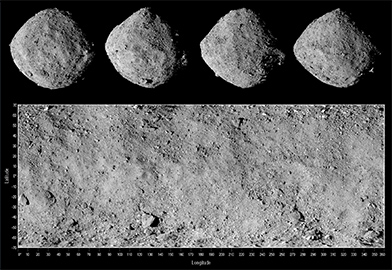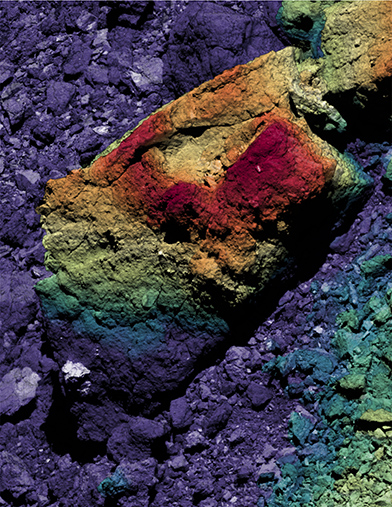News
Craters on Bennu Hint at When Asteroid Arrived to Its Near-Earth Neighborhood
Asteroid Bennu, the target that NASA’s OSIRIS-REx spacecraft briefly touched and sampled last week, may be a relatively new resident of near-Earth space, according to a new analysis published Oct. 26 in Nature.
The study suggests the asteroid has been orbiting near Earth for the last 1 million to 2.5 million years, a tiny fraction of its nearly 4.5-billion-year life. That finding validates decades of modeling studies that have estimated the lifetime of near-Earth asteroids, and it fills a gap in our understanding of the population of millimeter-to-centimeter-sized objects orbiting close to Earth.
Bennu is a rubble-pile asteroid, made of everything from microscopic grains to building-size boulders. Scientists suspect it formed in the asteroid belt between Mars and Jupiter from the debris of a larger parent asteroid and then slowly drifted closer to Earth thanks to gravitational tugs from the giant gas planets and the Yarkovsky effect — the slight push an asteroid feels when it absorbs sunlight and reemits it as heat.
Timestamping that event can be determined by examining the size of craters on the surface and how frequently those craters occur. And on small bodies like Bennu, those characteristics are strongly tied to the strength of the rocks in which the craters formed.
“Getting information about the strength is critical to making sure we’re not making some dramatic mistake in estimating the ages of these surfaces,” said Olivier Barnouin, a planetary scientist at the Johns Hopkins Applied Physics Laboratory in Laurel, Maryland, and a co-author on the study.
But scientists haven’t been able to directly measure that strength on rubble-pile asteroids like Bennu. Carbon-rich meteorites, which are fragments of asteroids, images of other asteroids and measurements of craters on lunar samples from the Apollo era offer some clues, but with many caveats.

Credit: NASA/Goddard/University of Arizona
That’s where OSIRIS-REx (short for Origins, Spectral Interpretation, Resource Identification, and Security-Regolith Explorer) came in. It provided detailed surface images taken by the spacecraft’s PolyCam instrument as well as topographic data collected by the OSIRIS-REx laser altimeter (OLA) instrument. With that information, the team identified more than 300 craters on the asteroid’s boulders, ranging from 16 feet (5 meters) to less than 1.6 feet (0.5 meters) wide, which they used to estimate the boulders’ strength.
They found the boulders were incredibly soft, from 10 to 100 times weaker than any rock on Earth. Barnouin suspects that’s because of their chemical makeup and very different geologic history.
“These are rocks that don’t go through the same processes that ours go through on Earth,” he said, and do not undergo the same heating and pressures.
Bennu’s large craters (wider than 16 feet) likely accumulated for a long time, the team determined, first forming when Bennu was still in the asteroid belt. But the measured rock strength that the team determined indicates that small craters that are 1.5 feet across or less were likely formed by tiny objects near Earth that are only 0.03–1 inch (0.07–2.5 centimeters) long — a population that models to date have not captured well. From that, the team estimated Bennu has been near Earth for just roughly 1.75 million years.
“We provide direct evidence that small asteroids with microgravity environments can retain fragments that experience violent collisions, providing a means of measuring the surface exposure ages of small bodies in the solar system,” said Ronald-Louis Ballouz, an astrophysicist at the University of Arizona in Tucson and the lead author of the study.
While OSIRIS-REx is slated to return with its sample by 2023, providing material that can be tested in a lab, having a technique that allows researchers to make strength measurements remotely opens many possibilities for studying and aging other asteroids.
Between the many surprises found on Bennu — from particles falling off its surface to the weak strength of its rocks — and this new capability, Barnouin sees it as a reason to invest in missions that “tour” multiple asteroids in the solar system.
“Bennu is much more complex than we initially thought,” he said. “It seems that products of a disrupted parent asteroid can take many paths. Each has a complex story to tell, so we need to keep exploring asteroids to get a complete picture of their formation and evolution.”
